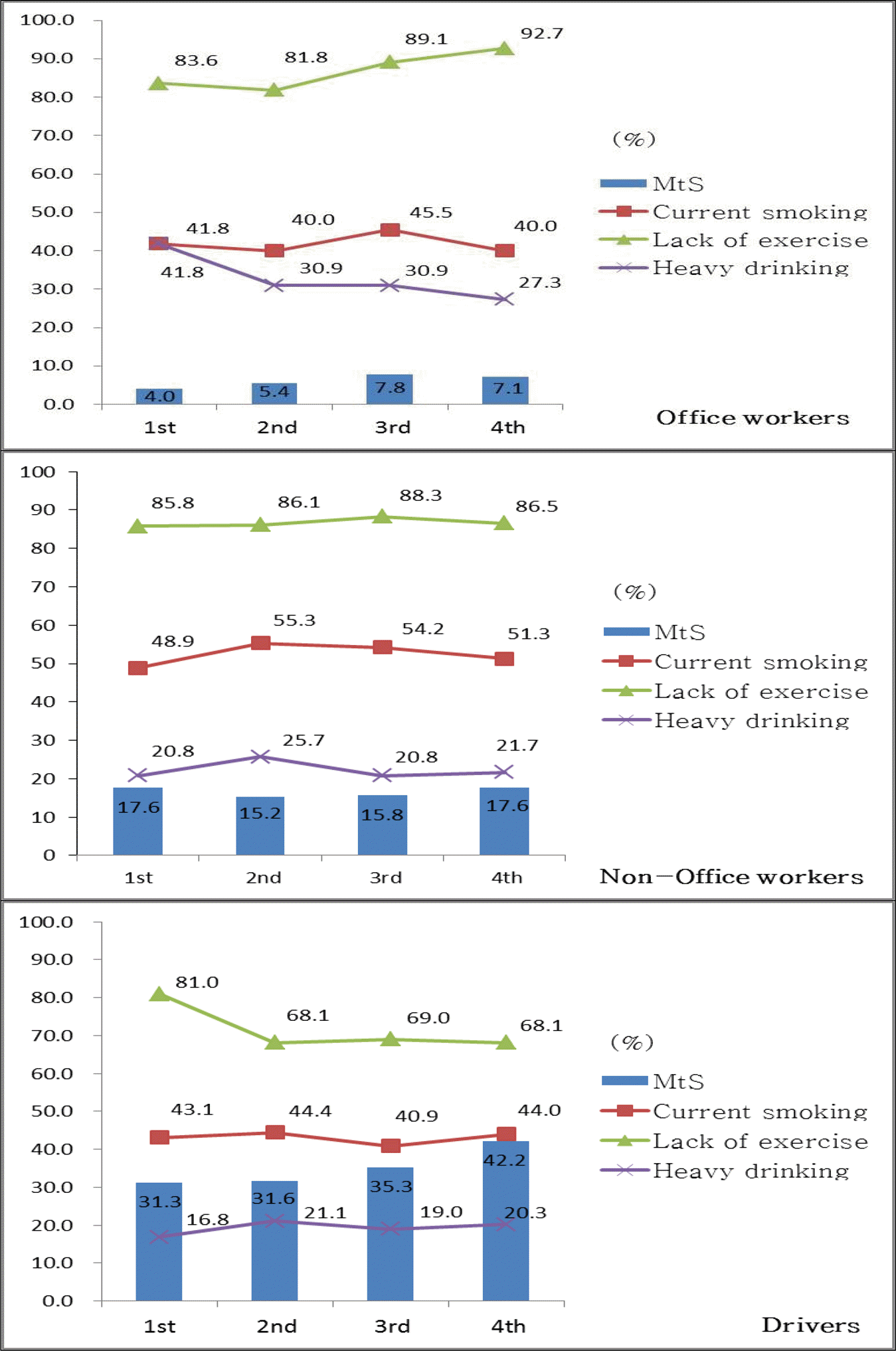Abstract
Purpose
This study examined the influence of occupational type and lifestyle habits on the prevalence of metabolic syndrome (MetS) among Korean male workers.
Methods
Through secondary analysis of their four-year health examination data, 3,892 subjects were divided into four subgroups according to the presence of MetS now and four years ago.
Results
Nineteen percent (n=739) suffered from MetS and these 739 subjects were classified into following occupations: 7.1% were office workers, 17.6% were non-office workers, and 42.2% were drivers. Multiple logistic regression analyses showed that when the data adjusted for age, the predicting factors on the prevalence of MetS were heavy drinking (OR 1.34, 95% CI 1.09~1.64) and the occupation of non-office workers (OR 2.99, 95% CI 2.13~4.18) and drivers (OR 7.97, 95% CI 4.89~10.83) among workers without MetS four years ago. Among workers already with a history of MetS, the predicting factors were less exercise (OR 1.55, 95% CI 1.02~2.35) and drivers (OR 2.21, 95% CI 1.03~2.94).
Go to : 
REFERENCES
1.American Heart Association Nutrition Committee. Lichtenstein AH., Appel LJ., Brands M., Carnethon M., Daniels S, et al. Diet and lifestyle recommendations revision 2006: a scientific statement from the American Heart Association Nutrition Committee. Circulation. 2006. 114(1):82–96.
2.Yoo JS., Jeong JI., Park CG., Kang SW., Ahn JA. Impact of life style characteristics on prevalence risk of metabolic syndrome. Journal of Korean Academy of Nursing. 2009. 39(4):594–601. http://dx.doi.org/10.4040/jkan.2009.39.4.594.

3.Korea Ministry of Health and Welfare. Korean national health and nutrition examination survey '07~'10 [Internet]. Sejong: Ministry of Health and Welfare;2012. [cited 2014 November 17]. Available from:. http://www.mohw.go.kr/front_new/al/sal0301vw.jsp?PAR_MENU_ID=04&MENU_ID=0403&CONT_SEQ=268137&page=1.
4.Statistical Korea. Annual report on the economically active population survey 2013 [Internet]. Seoul: Statistics Korea;2013. [cited 2014 November 17]. Available from:. http://kosis.kr/ups3/service/ch_file_down.jsp?PUBCODE=WA&FILE_NAME=/ups3/upload/101/WA/EAP_Y2013.pdf&SEQ=475.
5.Korea Ministry of Employment and Labor. The occurrence status of an occupational accident 2014 [Internet]. Sejong: Ministry of Employment and Labor;2014. [cited 2014 December 2]. Available from:. http://www.moel.go.kr/view.jsp?cate=3&sec=3&smenu=4&mode=view&state=A&bbs_cd=106&1417495374702&seq=14 17495374702.
6.American Heart Association. Understand your risk of heart attack: Risk factors and coronary heart disease [Internet]. Greenville: American Heart Association;2015. [cited 2015 November 20]. Available from:. http://www.heart.org/HEARTORG/Conditions/HeartAttack/HeartAttackToolsResources/Heart-Attack-Risk-Assessment_UCM_303944_Article.jsp#.Vxdajrdf3cs.
7.Mottillo S., Filion KB., Genest J., Joseph L., Pilote L., Poirier P, et al. The metabolic syndrome and cardiovascular risk a systematic review and meta-analysis. Journal of the American College of Cardiology. 2010. 56(14):1113–32. http://dx.doi.org/10.1016/j.jacc.2010.05.034.
8.Ko DS., Park BY., Seok GH. Relation of health promotion behaviors and metabolic syndrome in daytime workers. The Korea Institute of Electronic Communication Sciences. 2013. 8(12):1941–8. http://dx.doi.org/10.13067/JKIECS.2013.8.11.1941.

9.Lee MS., Kang HJ., Oh HS., Paek YM., Choue RW., Park YK, et al. Effects of worksite nutrition counseling for health promotion: twelve-weeks of nutrition counseling has positive effect on metabolic syndrome risk factors in male workers. Korean Journal of Community Nutrition. 2008. 13(1):46–61.
10.Kim YH., Park RJ., Park WJ., Kim MB., Moon JD. Predictors of metabolic syndrome among shipyard workers and its prevalence. Korean Society of Occupational & Environmental Medicine. 2009. 21(3):209–17.

11.Do KA., Jung HS., Choi EH. Association between job-related factors and metabolic syndrome among male and female workers: using the korean national health and nutrition examination survey. Korean Journal of Occupational Health Nursing. 2015. 24(1):39–47. http://dx.doi.org/10.5807/kjohn.2015.24.1.39.

12.Kim AR., Kwak CY., Yim ES. Influencing factors for and medical expenditures of metabolic syndrome among public officials. Korean Journal of Occupational Health Nursing. 2012. 21(3):209–20. http://dx.doi.org/10.5807/kjohn.2012.21.3.209.

13.Tak YR., An JY., Kim YA., Woo HY. The effects of a physical activity behavior modification combined intervention (PABMin-tervention) on metabolic risk factors in overweight and obese elementary school children. Journal of Korean Academy of Nursing. 2007. 37(6):902–13.
14.Park EO., Choi SJ., Lee HY. The prevalence of metabolic syndrome and related risk factors based on the KNHANESV 2010. Journal of Korean Society for Agricultural Medicine and Community Health. 2013. 38(1):1–13. http://dx.doi.org/10.5393/JAMCH.2013.38.1.001.
15.Kim KR. Retrospective cohort study for risk factors of metabolic syndrome in a periodic health examination. [dissertation]. Seoul: Hanyang University;2012. p. 1–35.
16.Korea Ministry of Government Legislation. Framework act on worker's welfare [Internet]. Sejong: Korea Ministry of Government Legislation;2015. [cited 2016 January 25]. Available from:. http://www.law.go.kr/lsSc.do?menuId=0&subMenu=1&query=%EA%B7%BC%EB%A1%9C%EB%B3%B5%EC%A7%80%EA%B8%B0%EB%B3%B8%EB%B2%95#undefined.
17.National Health Insurance Service. Health check implement guide 2014 [Internet]. Wonju: National Health Insurance Service;2014. [cited 2014 November 17]. Available from:. http://www.nhis.or.kr/menu/retriveMenuSet.xx?menuId=C4700.
18.Ko JK. Analysis of factors affecting the health behavior of taxi-drivers. Journal of East-West Nursing Research. 2009. 15(2):71–81.
19.Kim EY., Hwang SY. Incidence risk of cardiocerebrovascular disease, preventive knowledge, stage of change and health behavior among male bus drivers. Korean Journal of Adult Nursing. 2011. 23(4):321–31.
20.Editorial department. The Great Encyclopedia of Nursing Science. 1st ed. Seoul: KDR;1996.
21.Lee YO., Cho YH. Factors affecting the preventive behavior of cardiocerebrovascular disease in blue color workers. The Korean Journal of Rehabilitation Nursing. 2013. 16(1):63–70. http://dx.doi.org/10.7587/kjrehn.2013.63.

22.Lim MY., Lee YR., Han SJ., Cho CM. The effects of lifestyle factors on metabolic syndrome among korean adults. Journal of Korean Academy Community Health Nursing. 2012. 23(1):3–21.
23.Oh JE. Association between smoking status and metabolic syndrome in men. Korean Society for The Study of Obesity. 2014. 23(2):99–105.

24.Kang SW. The validity and reliability of a lifestyle evaluation tool for patients with metabolic syndrome. Journal of Korean Academy fundamentals of Nursing. 2010. 17(4):487–97.
Go to : 
 | Figure 1.Current lifestyle habits of male workers with metabolic syndrome by occupational type. |
Table 1.
Comparison Male Workers' Characteristics by of Occupational Type (N=3,892)
Table 2.
Prevalence of Metabolic Syndrome Current and Four Years ago (N=3,892)
| Variables | MetS (Current) | Non-MetS (Current) | x2 | p |
|---|---|---|---|---|
|
MetS (4 yrs ago) Non-MetS (4 yrs ago) |
Group 4: n=257, 6.6% Group 3: n=482, 12.4% |
Group 2: n=399, 10.3% Group 1: n=2,754, 70.8% |
209.07 | <.001 |
Table 3.
Differences in Male Workers' Characteristics of Four Sub-groups (N=3,892)
Table 4.
Predicting Factors on the Current Prevalence of MetS Compared with Non-MetS




 PDF
PDF ePub
ePub Citation
Citation Print
Print


 XML Download
XML Download